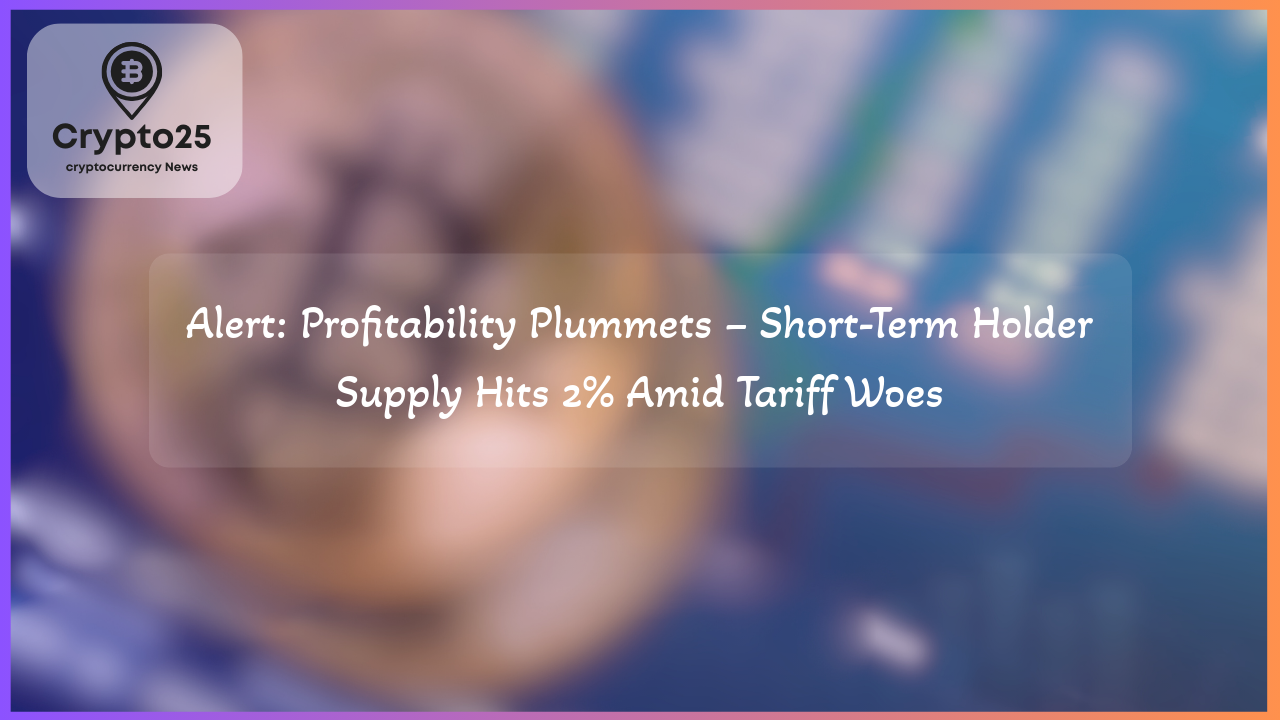
Bitcoin’s price movements and on-chain dynamics reveal critical insights into market behavior, particularly the delicate balance between short-term and long-term holders. Recent fluctuations, triggered by macroeconomic uncertainties, have significantly affected the profitability of Bitcoin’s short-term holders. However, while short-term traders grapple with losses, long-term holders appear largely unfazed, reflecting the enduring strength of Bitcoin’s market structure. Let’s delve deeper into these metrics and their implications for near-term and future trends.
### Short-Term Holder Profitability Crashes Amid Market Stress
One of the key indicators for assessing selling pressure in Bitcoin markets is short-term holder (STH) profitability. This metric measures the portion of coins held for less than 155 days that were acquired at a lower price than the current spot price. These coins are considered more speculative and responsive to near-term price actions. At the start of the year, STH profitability stood at a healthy 54.76%, with Bitcoin trading around $94,400. However, following a sharp rally that pushed prices above $104,000 by mid-January, short-term profitability surged to 95%.
Unfortunately, this optimism was short-lived. By April, macro-driven risks, including tariff increases, prompted a steep retracement, sending Bitcoin to a monthly low of $78,400. On-chain data from April 6 revealed that STH profitability had collapsed to a mere 2.07%, one of the lowest readings since the FTX crisis in November 2024. Such drastic losses indicate rising sensitivity among short-term holders, as panic selling often accompanies a dip in profitability metrics.
### Macro Uncertainty Drives Bitcoin Volatility
The collapse in short-term holder profitability is closely tied to macroeconomic factors, notably increasing US-China trade tensions. Bitcoin markets felt the impact when fears of a 145% reciprocal tariff affected investor sentiment. While a temporary recovery was attempted mid-April, with Bitcoin rebounding to $84,600 and STH profitability climbing to 26.39%, larger obstacles persist.
Trade data underscores the fragility of the global economy, with US imports plummeting 64% and exports declining 30% in the wake of escalating tariffs. This environment limits risk-on investment behavior, particularly among corporate treasuries and institutional players. While speculation grew about Bitcoin serving as a hedge against tariffs, inflows to spot exchange-traded funds (ETFs) remained subdued, highlighting uncertainty about Bitcoin’s near-term growth trajectory.
The road to recovery remains narrow for short-term holders, as any significant price rallies are met with resistance. STH wallets sitting on unrealized losses are likely to offload in strength as markets inch closer to breakeven price levels, creating supply-side friction at key thresholds such as $87,000–$90,000. As each $1,000 gain can push tens of thousands of STH coins back into profit, sell pressure builds gradually, tempering upward momentum.
### Long-Term Holders Maintain Market Stability
While short-term holders struggle with profitability, long-term holders (LTHs) remain resilient. Bitcoin’s LTH supply—with coins held for over 155 days—continues to exhibit stability despite price volatility. Through the first quarter of 2025, nearly 100% of LTHs were in profit. Even after the sharp April pullback, this cohort’s profitability dipped only marginally to 99.90%, underscoring the robustness of long-term accumulation strategies.
The resilience of LTHs can be attributed to Bitcoin’s structural market dynamics. Much of the recent long-term supply originated from the 2024 ETF bull run. During this period, Bitcoin ETFs attracted $35.5 billion in inflows, with coins acquired at prices ranging from $55,000 to $75,000. These inflows helped shift a significant portion of supply into the long-term holder category, locking in substantial unrealized gains. This trend has created a scarcity effect, as long-term holders traditionally engage in minimal selling, thus reinforcing Bitcoin’s broader bullish bias.
| Metric | Details |
|---|---|
| Market Cap | $1.2 Trillion |
| Short-Term Holder Profitability (April Low) | 2.07% |
| Long-Term Holder Profitability (April) | 99.90% |
The divergence between short-term and long-term holders highlights important dynamics at play in Bitcoin markets. While short-term traders drive intraday volatility and move the market during periods of stress, long-term participants offer stability, ensuring that macro-driven downturns do not unravel Bitcoin’s structural health.
### What Lies Ahead for Bitcoin Markets?
The recent shifts in short-term holder profitability and long-term supply dynamics illustrate the reflexive nature of Bitcoin markets. When STH metrics collapse to single digits, day-to-day selling pressure often diminishes due to a lack of latent supply. This was evident during the April drawdown, where limited profit-taking inventory helped Bitcoin stabilize despite sharp price declines.
However, challenges persist as the market navigates macroeconomic uncertainty. Short-term recovery is likely to be capped by psychological resistance levels where STH wallets regain parity. On the macro front, ongoing trade negotiations between the US and China will play a pivotal role in shaping risk sentiment. Until clarity emerges, Bitcoin is expected to trade within a tight band, driven by cautious optimism among LTHs and mounting pressure on STHs.
In conclusion, Bitcoin’s market structure remains a tale of two cohorts. Short-term holders, vulnerable to rapid swings, exhibit heightened sensitivity to price corrections. Long-term holders, however, provide the backbone for sustained market strength. As institutional flows and global macroeconomic factors evolve, these dynamics will continue shaping Bitcoin’s trajectory, offering valuable insights for traders and investors worldwide.
